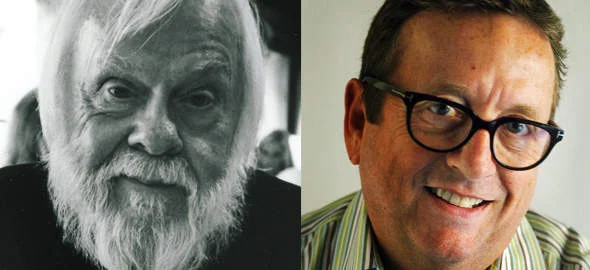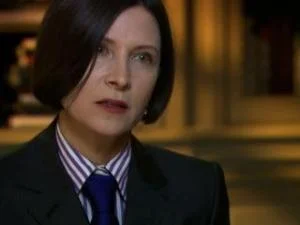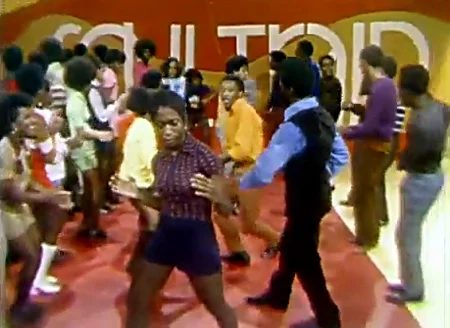Here's a clip that's getting some wide circulation, and with good reason, it's Iggy Pop walking around his Lower East Side neighborhood in 1993 with Dutch filmmaker Bram van Splunteren. They stop in a bakery and Iggy begs money to pay for their goods, he points out the local graffiti, speaks of his preference for Bob Dylan over Ice T, and talks about recently acting with Tom Waits in Jim Jarmusch's short film Coffee and Cigarettes, posted below. Have an Iggy day!
The folklorist Alan Lomax (1915-2002) was a pretty impressive individual. Recorder of many unknown musicians in the midst of their daily lives, as well as such figures as Woody Guthrie, Huddie Ledbetter (aka “Leadbelly”), Muddy Waters, and Jelly Roll Morton. With the recent Coen Bros movie taking on in satirical fashion the folk music revival of the 1960s, I thought it could be interesting for some to see this lively 1991 interview conducted by journalist Charles Kuralt with Lomax, who was a very unconventional fellow for his time, and as is clearly evidenced here, quite a talker. From the interview’s first part, Lomax describes the role of the folklorist:
“I think our job is to represent all the submerged cultures of the world. You and your CBS and all your big amusement industries represent a way of silencing everybody. You know communication was supposed to be two-way, but it’s turned out to be basically one-way. From those people who can afford to own a transmitter which costs a few million dollars to a little guy who can afford to buy a receiver which only costs a few bucks. … I think the most important thing anyone can do is to try and restore the balance. I call this cultural equity. The slogan is every culture with its equal time on the air and in the classroom. Cultural equity should join all the other principles of human dignity. … Freedom for every culture to express itself cause that’s all we’ve got you know. Culture … Human beings are about 98 % culture and 2 % individuals.”
For more on Lomax check out the Alan Lomax Archive at: http://www.culturalequity.org/. And jazz historian John Szwed (who previously wrote biographies on Miles Davis and Sun Ra) wrote a fascinating book on Lomax recently entitled The Man Who Recorded the World (2011).
Some artists are not very good interviewees, that is, they are not keen on being placed in the position of doing a job that either (a) the work itself, or (b) some other kind of folk such as curators, critics, historians might be doing. John Baldessari is not one of those artists. He appears on camera a bit like some giant, dryly humorous polar bear. But this artist arguably created some of the most important conceptual gestures and works of the past fifty years. For a long time Baldessari was an art professor and a kind of “artists’ artist” somewhat under the radar but always there. Wider recognition seems to have increased exponentially since his 2009 career retrospective. I used to carry around a 1990 Rizzoli book (the only major one on his work at that time) and practically memorized certain passages and images. Like a lot of great artists, he was (though not his fault) likely a bad influence on me as I spent a large portion of my MFA degree trying to create Baldessari-styled critiques of photography. But while many of my works may have been terrible, Baldessari’s own ideas, process, measured good humour and lively incorporative mode of viewing the world made a huge impact on me. Thought now that videos on the artist are plentiful on the interweb, I would post a few here. You can also watch some of Baldessari's videos in full as well as another good 1990 documentary on the artist by Peter Kirby entitled Some Stories here: http://www.ubu.com/film/baldessari.html
I definitely do have a thing for reclusive American writers: JD Salinger, Thomas Pynchon, Harper Lee. (In high school I was so nerdy that I sat in the local university library and looked up unpublished Salinger stories on microfilm. I won’t go into any further detail sorry.) So it might follow that Donna Tartt who just published her third novel within a span of 20+ years and is spoken of as publicity shy might be of interest to me. Well, I did read her massively hyped and massive in sheer-length latest entitled The Goldfinch over the Xmas holidays. I found myself feeling a bit guilty about devouring a book that I am being told by the media around that time to devour (for example I have enjoyed Jonathan Franzen’s essays tremendously but Freedom…!) And I’ve never been a great Dickens reader (poisoned at school) except watching BBC costume dramas—does that count? At any rate, back to Tartt (compared to Dickens by the doorstop creating horror machine Stephen King in the N Y Times) I really enjoyed the first half of the book, a mix between a paranoiac mystery crime story and a behind-the-scenes look at Antiques Roadshow. I guess I did like the fact that despite its utter preposterousness and over the top qualities, it engaged me with smooth prose and a few vivid characters, most significantly Boris, the Russian boyhood friend of the narrator, whose moral code is rather relativistic (to say the least) and focussed on moment-to-moment hedonism and the joyful experience of life. If nothing else would have pulled me along in the novel it is Boris’s wild, enviable spirit, which Tartt conjures obviously with great relish and more subtlety (at least earlier in the book) than many other aspects of the novel. I also read the UK review of The Goldfinch that’s been nominated for “hatchet job” of the year written by Peter Kemp in the Sunday Times. But the aforementioned Stephen King certainly knows his way around narratives that grip huge audiences so he’s quite aware of the tactical moves Tartt made to create what he calls “a rarity that comes along perhaps half a dozen times per decade, a smartly written literary novel that connects with the heart as well as the mind.” I’m still deciding my own verdict, despite having pressed the buttons of my worn (and now extra-worn) Kindle at a rapid click while avoiding wrapping my daughters’ Xmas doodads. But just ran across these video interviews with Tartt who looks a bit like a startled and overdressed Asperger-ish little bird who spouts platitudes in both. That is to say, interesting performances of the “writer in public.” I’m not certain that these clips would have encouraged me to pick up the book if I’d seen them earlier, but they serve as perverse little examples of how big media news “handles” fiction—the obviously clever Charlie Rose always sounds pretty awful in these encounters.
I recently got back in touch, albeit virtually, with an old friend Mark Poole who is the singer and guitarist for an excellent band called The Phantom Six based in Morgantown, West Virginia, USA. Mark is a terrifically talented musician and now runs a recording studio called Zone 8. Mark has been involved in many amazing bands since the 1980s including Moon (which included the current members of The Phantom Six), and 63Eyes, whom I saw long ago but linger strongly in my cranium. They were a phenomenally tight post-punk outfit, and similarly, the collective musicianship of The Phantom Six is entirely formidable. Although they draw upon many rock, pop, and alternative touchstones they offer an original amalgam as a wholly credible alternative to autotuned mediocrity. For much more info and to support their music go to: http://thephantomsix.com/.
I caught the Japanese musician Masami Akita's performance in Wellington in November. Known generally under the name "Merzbow" he is frequently called "the godfather" of noise. The performance was so loud that even though it lasted under an hour, it's probably lucky i've still got my hearing, as my ears rang for days (yes I stupidly did not wear earplugs!). I found this video of a performance recorded a couple of months earlier at Oberlin College in Ohio, and thought it would be interesting for those who don't run in the opposite direction of such sounds. Irish academic Paul Hegarty in his fine study Noise/Music: A History (Continuum Books, 2007) devotes a whole chapter to Merzbow and writes: "Duration, volume, harshness, interference, luring a listener into attributing meaning, and anti-virtuosity are all tools that work through the layers of harsh noises, pulses, oscillations, crashes and explosive bursts in Merzbow recordings. The quantity of his releases, even within the prolific production of Japanese noise musicians, is immense, to the point where Masami Akita could constitute a genre in his own right." For much more on Merzbow, see: http://merzbow.net/
I recently re-watched Spike Lee’s 1994 film Crooklyn, an autobiographical account of life growing up in Brooklyn in the early 1970s with his four siblings. Lee co-wrote the script with two of them, Joie Susannah and Cinqué. Crooklyn has tremendous performances and cinematography as is characteristic of Lee’s best films. Most of the action takes place through the eyes of Troy, played by 10-year-old first time actress Zelda Harris. Lee’s parents are conjured in (nearly over the top but) utterly believable style by Alfre Woodard and Delroy Lindo. Memorable moments include the kids huddled around both Soul Train and the Partridge Family (just to jog your memory or introduce those programs see below—enjoy!) on television, Troy’s “vacation” in the South with her aunt and uncle, and Ru Paul dancing in the local bodega (see clip below). With its exacting attention to detail Crooklyn becomes both an impressive period piece and an affecting drama incorporating comedic surrealism (Lee playing a bullying glue sniffer, camera aspect ratio shifting while Troy is visiting down South, arguments with an ornery musician neighbor portrayed by David Patrick Kelly who serenades his pack of dogs).
Two videos featuring Lou Reed, one of them an interview recorded shortly before his death last year, and the other a 1983 performance with, to my mind, his greatest post-Velvet Underground band, Fernando Saunders (bass), Robert Quine (guitar), and Fred Maher (drums) who backed Reed in support of the amazing album The Blue Mask. Here is the dark and moving Waves of Fear with a totally deranged guitar solo by Quine. The mellifluous bass of Saunders acts as counterpoint but doesn't remove the edgy feel they cultivated at their peak. Quine and Reed had infamously tense relations, but were a terrific guitar duo.
Perhaps not everyone will want to read a 600+ page book on Johnny Cash. But if you are that sort of person, Robert Hilburn’s new biography is a much more comprehensive tome than any of the previous attempts to filter through the manifold complexities of the Man in Black’s psyche. While Cash’s contributions to American music are pretty much incontestably clear today, this hasn’t always been the case. As Hilburn outlines, in painstaking fashion, throughout the 1970s and 80s, even as Cash became lionized as an iconic figure of popular culture, his record sales were poor, production values mediocre, and he was dropped from his longtime label. Of course the rejuvenation of his career during the later years working with producer Rick Rubin turned this around to an enormous degree, enabling a reconsideration of Cash’s importance to so many musical genres: rock and roll, rockabilly, country, blues, folk, and gospel. Hilburn, a veteran music critic gets his facts straight, sometimes at the expense of a gripping narrative, as the second half of the book gets rather more pedestrian. Cash’s own autobiography, while sketchy in terms of some of the particulars remains a riveting read and offers a nice compliment to Hilburn’s archival and journalistic foraging. However both are probably good recommendations for airplane reading if you are a Cash fanatic, and if you aren’t, what’s keeping you?
In light of the burgeoning interest in "tiny houses," it's an apt time to remember the late American architect Samuel Mockbee (1944-2001), founder of the Rural Studio in Hale County, Alabama. Here's a trailer for an exceptional 2010 documentary, and for more on Mockbee and his legacy, see:





















